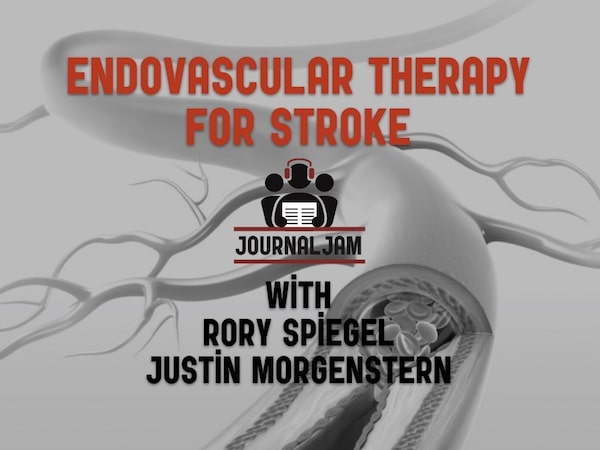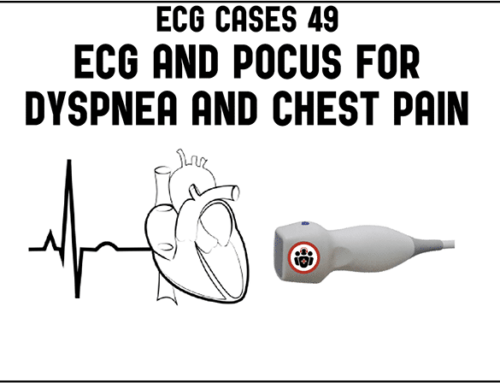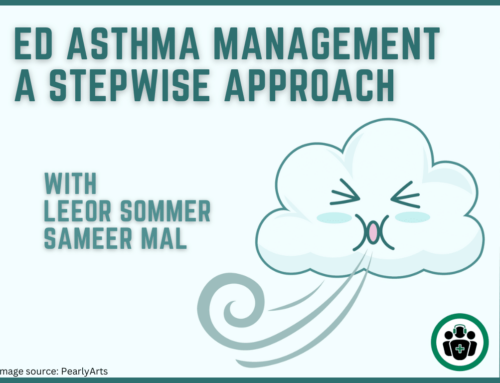In this part 2 of EM Cases Journal Jam podcast on Thrombolysis and Endovascular Therapy for Stroke Justin Morgenstern, Rory Spiegel and Anton Helman do a deep dive into the world’s literature on endovascular therapy for stroke. While the evidence for endovascular therapy is stronger than that for IV systemic thrombolysis for stroke outcomes at 90 days, a closer look at the literature reveals that a very small minority of patients are eligible for endovascular therapy and we still don’t know which patients benefit most from endovascular therapy…
Podcast produced by Anton Helman, Justin Morgenstern and Rory Spiegel; sound design and editing by Anton Helman; EBM bomb by Anton Nikoline.
Written Summary and blog post by Anton Helman July, 2016
Cite this podcast as: Morgenstern, J, Spiegel, R, Helman, A. Part 2 Endovascular Therapy for Stroke. Emergency Medicine Cases. July, 2016. https://emergencymedicinecases.com/endovascular-therapy-stroke/. Accessed [date].
Endovascular Therapy for Stroke Trials
Adapted from R.E.B.E.L. EM
| IMS-III | Broderick JP | 2013 | No benefit | |
| MR RESCUE | Kidwell CS | 2013 | No benefit | |
| SYNTHESIS | Ciccone A | 2013 | No benefit | |
| MR CLEAN | Fransen PS | 2014 | 13.5% disability benefit | |
| ESCAPE | Goyal M | 2015 | 24% disability benefit | |
| EXTEND IA | Campbell BC | 2015 | 31% disability benefit | |
| SWIFT PRIME | Saver JL | 2015 | 26% disability benefit | |
| REVASCAT | Jovin TG | 2015 | 16% disability benefit | |
| THRACE | Bracard S | 2016 | 11% disability benefit | |
| THERAPY | Mocco J | 2016 | 8% disability benefit |
A very small percentage of patients with acute stroke (about 1%) will be eligible for endovascular therapy. Most of the trials listed above enrolled patients with anterior circulation large vessel severe strokes that have demonstrable salvageable brain tissue on imaging.
Issues with these endovascular therapy for stroke trials
- Open label (not blinded)
- Many were stopped early
- Inclusion criteria were heterogeneous between trials – different imaging requirements, differents timeframes, most people got tPa (but some didn’t), different interventions in addition to thrombectomy
- Indication creep (see this post by Kevin Klauer for explanation)
Food for thought on endovascular therapy for stroke
The bigger question is whether the small benefits of endovascular therapy to a very small number of patients is worth the larger societal costs of interventional radiologists on call, equipment, administration etc. for “code stroke” to be called at any time of day.
Drs. Helman, Morgenstern and Spiegel have no conflicts of interest to declare
References
Broderick JP et al. Endovascular Therapy After Intravenous t-PA Versus t-PA Alone for Stroke. NEJM 2013; 368(10): 893-903.
Kidwell CS et al. A Trial of Imaging Selection and Endovascular Treatment for Ischemic Stroke. NEJM 2013; 368(10): 914-23.
Ciccone A et al. Endovascular Treatment for Acute Ischemic Stroke. NEJM 2013; 368(10): 904-13.
Fransen PS et al. A Randomized Trial of Intraarterial Treatment for Acute Ischemic Stroke. NEJM 2015; 372(1): 11-20.
Goyal M et al. Randomized Assessment of rapid Endovascular Treatment of Ischemic Stroke. NEJM 2015; 372(11): 1019-30.
Campbell BC et al. Endovascular Therapy for ISchemic Stroke with Perfusion-Imaging Selection. NEJM 2015; 372(11): 1009-18.
Saver JL et al. Stent-Retriever Thrombectomy after Intravenous t-PA vs t-PA Alone in Stroke. NEJM 2015; 372(24): 2285-95.
Jovin TG et al. Thrombectomy Within 8 Hours After Symptom Onset in Ischemic Stroke. NEJM 2015; 372(24): 2296-306.
Bracard S, Ducrocq X, Mas JL, et al. Mechanical thrombectomy after intravenous alteplase versus alteplase alone after stroke (THRACE): a randomised controlled trial. Lancet Neurol. 2016;15(11):1138-47.
Mocco J et al. Aspiration Thrombectomy After Intravenous Alteplase Versus Intravenous Alteplase Alone. Stroke. 2016;47(9):2331-8.
Other FOAMed Resources on Endovascular Therapy for Stroke
First10EM Interventional Therapy for Acute Ischemic Stroke: The Evidence
EMDocs Endovascular Stroke Therapy: Is this the new standard?
The SGEM reviews the 2015 JAMA Meta-analysis on endovascular stroke treatement
EMLit of Note Christmas Comes Early for Endovascular Therapy in Stroke





Hi there, I’m a ground paramedic, and I found this series on tPA and EVT incrediblely informative, especially since I give TNK in the field to STEMI patients a couple of times a year and was completely sold on the idea that fibrinolytics in CVA would have similar effects. My practice unfortunately can’t change, but I think having this information will make me a better patient advocate as our code stroke guys definitely don’t seem to have a discussion about tPA and consider it standard of care, so I can give the family & patient better information during the transport to hospital.
I’m interested in your thoughts on what we’re now doing in Alberta with EVT.
In your podcast you suggest that there would need to be a significant system change to capture the right patients that would benefit from EVT, and it appears that we maybe have accomplished that. Pre-hospital we now incorporate a LAMS score assessment & any patient >/= 4 on the scale /=4 indicates large vessels occlusion and EVT will benefit the patient, and that by moving to this we’ll be capturing approximately 400 patients a year.
http://www.albertahealthservices.ca/scns/Page13274.aspx
Do you think the data supports going this widespread with this? I thought your comment on taking the ambulance out of the community to support this was interesting considering the mixed evidence and if you think that supporting something like this provincially could actually cause harm as those ambulances are no longer available.
Thanks for the comment Sean.
Based on what we know now, I think we are a long way from knowing exactly who should be transported for possible endovascular therapy. None of the trials we discussed used the LAM score, so strictly speaking, there is not great evidence. After a quick read through the LAM evidence, I think there are 2 issues. First, having a large vessel occlusion is not the same as having salvageable brain tissue, so it might be identifying the wrong patients from the outset. Second, at a cutoff of 4, the LAM score seems to have a sensitivity of about 80% and a specificity of about 90%. Those numbers aren’t perfect, but the real problem is that when you try to apply imperfect tests to rare conditions – and very few people qualify for EVT – you get even worse results. That being said, it certainly seems like a better approach than simply transporting all stroke patients.
I definitely worry about increasing specialization and the overall effect on the system, such as losing ambulances to small communities for prolonged periods. This is why we all have to be involved in these conversations, not just the specialists whose world view is shaped by referral bias.
Glad you are interested in these topics. Stay safe out there.
Hey guys, great series.
Two thoughts…
First, I think you’re being too generous regarding the possible utility of tPa. When a dozen studies, many of which were funded by the industry, mostly showed either no benefit or outright harm, and only showed benefit when there was a difference in baseline stroke severity that favored tPa (and even then both studies had a fragility index of less than 10), I think the weight of evidence would suggest that this therapy is harmful, but at the very least is not beneficial. While replicating NINDS could formally put the nail in the proverbial coffin, I don’t think that is, intellectually, necessary (although it likely would be for our regulating agencies)
Secondly, regarding endovascular therapy: while I sympathize with the hope that EVT could offer some benefit, I remain far more skeptical, as we have seen this same process fail in the orthopedic literature. In addition to the unfortunate similarities to the original tPa literature that you mentioned, there are also similarities to the orthopedic literature on arthroscopic surgery for meniscal injuries. We once considered arthroscopic lavage or debridement beneficial for meniscal injuries – and we noted significant improvement after these surgeries – until two blinded studies demonstrated that simply sedating the patient and making two nicks in the skin over their knee demonstrated the same improvement. I suspect that we are seeing the same narrative played out in the neurological literature now. We have abundant literature demonstrating the powerful effect of placebo, and what better placebo could you get than a wound to remind you that the medical system really tried hard to help you?